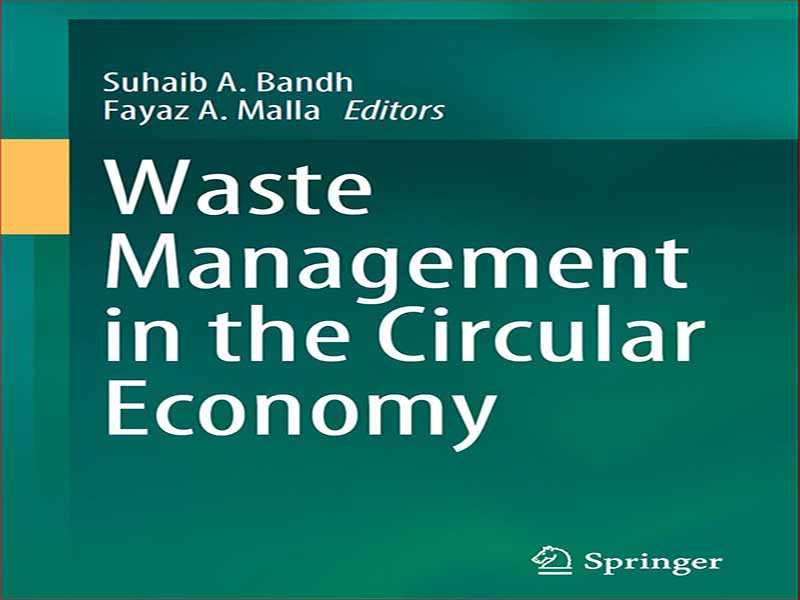- عنوان کتاب: Waste Management in the Circular Economy
- نویسنده: Suhaib A. Bandh
- حوزه: اقتصاد دایره ای, مدیریت پسماند
- سال انتشار: 2023
- تعداد صفحه: 325
- زبان اصلی: انگلیسی
- نوع فایل: pdf
- حجم فایل: 8.43 مگابایت
با افزایش مقدار تولید زباله، مدیریت پسماند به یک موضوع ضروری تبدیل شده است که نیاز به توجه و اقدام فوری دارد. نیاز به یک رویکرد پایدارتر برای مدیریت زباله وجود دارد و راه حل می تواند مفهوم اقتصاد دایره ای باشد (Ribi’c et al., 2017).
مدیریت پسماند و اقتصاد دایره ای مفاهیمی نزدیک به هم و وابسته به یکدیگر هستند که در سال های اخیر توجه زیادی را از سوی سیاست گذاران و شرکت های آگاه به محیط زیست به خود جلب کرده اند. مدیریت زباله شامل جمعآوری، حمل و نقل و دفع مواد زائد از طریق روشهای مختلف مانند دفن زباله، سوزاندن یا بازیافت است (ناندا و بروتی، 2021). از سوی دیگر، اقتصاد دایره ای یک مدل اقتصادی است که هدف آن حفظ منابع در استفاده به جای دور ریختن آنها از طریق طراحی زباله و آلودگی، حفظ محصولات و مواد در استفاده و بازسازی سیستم های طبیعی است.
مدل سنتی اقتصاد خطی، که مبتنی بر رویکرد “بکار بردن، استفاده کردن، دور انداختن” است، با توجه به جمعیت رو به رشد، دسترسی محدود به منابع، و مسائل محیطی مبرمی که امروزه با آن مواجه هستیم، مانند تغییرات آب و هوا، هوا، دیگر پایدار نیست. ، و آلودگی آب (Dissanayake، 2022). بنابراین، اقتصاد دایره ای جایگزین پایدارتری ارائه می دهد که به نفع اقتصاد، جامعه و محیط زیست است. این سیستم یک سیستم حلقه بسته را ترویج می کند که بر کاهش زباله، استفاده مجدد، نوسازی و بازیافت به جای دفع پایان عمر مدل خطی تاکید دارد (راجک و همکاران، 2022).
مدیریت زباله با جمعآوری و جداسازی مواد زائد که میتوانند در فرآیند تولید مجدداً مورد استفاده قرار گیرند، نقش مهمی در حمایت از اقتصاد دایرهای ایفا میکند (Arena et al., 2021). برای مثال، بازیافت بطریهای پلاستیکی میتواند در کاهش تقاضا برای مواد بکر و کاهش انتشار گازهای گلخانهای مرتبط با استخراج و حمل و نقل کمک زیادی کند. فناوریهای تبدیل زباله به انرژی، مانند سوزاندن یا تبدیل به گاز، همچنین میتوانند برای تبدیل زبالهها به انرژی، کاهش اتکا به سوختهای فسیلی و کاهش تغییرات آب و هوایی استفاده شوند.
یکی از نمونه های برجسته شرکتی که اقتصاد دایره ای را پذیرفته است، غول چندملیتی IT، Dell است (ژانگ و همکاران، 2022). این شرکت یک فرآیند بازیافت حلقه بسته را اجرا کرده است که رایانه های مستعمل را جمع آوری می کند، آنها را به رایانه های جدید بازیافت می کند و به مشتریان می فروشد. رویکرد دل نه تنها زباله های ارسالی به محل های دفن زباله را کاهش می دهد، بلکه باعث صرفه جویی در هزینه و مزایای بهره وری انرژی می شود.
نمونه دیگری از سیستم مدیریت زباله دایره ای، رویکرد شهر آمستردام برای مدیریت جامدات زیستی است که محصولات جانبی جامد حاصل از تصفیه فاضلاب هستند. آمستردام یک مرکز ابتکاری نصب کرده است که بیوسولیدها را به فسفر، یک عنصر حیاتی در کود، پردازش می کند (Gianico et al., 2021). با این کار، شهر اثرات زیست محیطی دفع زباله را کاهش داده و از هدر رفتن منابع ارزشمند جلوگیری کرده است.
رابطه بین مدیریت پسماند و اقتصاد دایره ای همزیستی است و هر یک از اهداف و مقاصد دیگری حمایت و تقویت می کند. مدیریت زباله به اطمینان از جمعآوری، جداسازی و پردازش کارآمد مواد زائد که به سیستم حلقه بسته اقتصاد دایرهای کمک میکند، کمک میکند. مزایای اتخاذ یک مدل اقتصاد دایره ای، با کاهش ضایعات و آلودگی، فرصت های تجاری جدید، صرفه جویی در هزینه ها، و رشد اقتصادی پایدارتر قابل توجه است (Androniceanu et al., 2021). در حالی که اجرای اقتصاد دایره ای نیاز به سرمایه گذاری قابل توجهی از سوی دولت ها و شرکت ها دارد، پاداش های بالقوه ارزش تلاش را دارد.
With the growing quantity of waste generation, the waste management has become an essential issue that needs urgent attention and action. There is a need for a more sustainable approach to waste management, and the solution could be the circular economy concept (Ribi´c et al., 2017).
Waste management and the circular economy are closely related and mutually dependent concepts that have gained increased attention from policymakers and eco-conscious companies in recent years. Waste management involves the collection, transportation, and disposal of waste materials through various methods, such as landfilling, incineration, or recycling (Nanda & Berruti, 2021). On the other hand, the circular economy is an economic model that aims to keep resources in use instead of throwing them away by designing out waste and pollution, keeping products and materials in use, and regenerating natural systems.
The traditional linear economy model, which is based on a take-make-use-throwaway approach, is no longer sustainable given the growing population, the limited availability of resources, and the pressing environmental issues we face today, such as climate change, air, and water pollution (Dissanayake, 2022). Therefore, the circular economy offers a more sustainable alternative that benefits the economy, society, and the environment. It promotes a closed-loop system that emphasizes waste reduction, reuse, refurbishment, and recycling instead of the linear model’s end-of-life disposal (Rajak et al., 2022).
Waste management plays a critical role in supporting the circular economy by collecting and separating waste materials that can be reused in the production process (Arena et al., 2021). For example, recycling plastic bottles can go a long way in reducing the demand for virgin materials and cutting down on greenhouse gas emis-sions associated with extraction and transportation. Waste-to-energy technologies, such as incineration or gasification, can also be used to convert waste into energy, reducing reliance on fossil fuels and mitigating climate change.
One prominent example of a company that has embraced the circular economy is the multinational IT giant, Dell (Zhang et al., 2022). The company has implemented a closed-loop recycling process that collects used computers, recycles them into new ones, and sells them back to customers. Dell’s approach not only reduces waste sent to landfills but also delivers cost savings and energy efficiency benefits.
Another example of a circular waste management system is the city of Amsterdam’s approach to managing biosolids, which are the solid by-products from wastewater treatment. Amsterdam has installed an innovative facility that processes biosolids into phosphorus, a vital ingredient in fertilizer (Gianico et al., 2021). By doing so, the city has reduced the environmental impact of waste disposal and prevented the loss of valuable resources.
The relationship between waste management and the circular economy is symbi-otic, with each supporting and reinforcing the other’s goals and objectives. Waste management helps to ensure the efficient collection, separation, and processing of waste materials that contribute to the circular economy’s closed-loop system. The benefits of adopting a circular economy model are significant, with reduced waste and pollution, new business opportunities, cost savings, and more sustainable economic growth (Androniceanu et al., 2021). While implementing a circular economy requires significant investment from governments and companies, the potential rewards are well worth the effort.
این کتاب را میتوانید از لینک زیر بصورت رایگان دانلود کنید:
Download: Waste Management in the Circular Economy




































نظرات کاربران